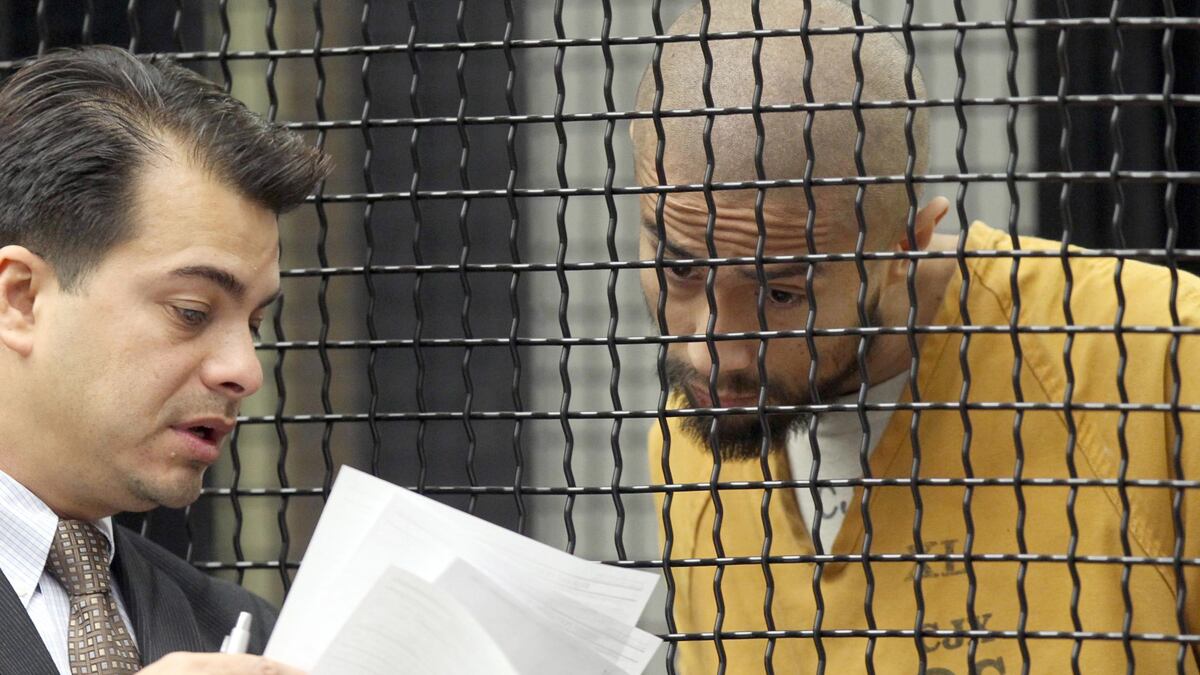Against the recent backdrop of American soldiers going postal, a newly released grand jury transcript provides a chilling look into the twisted mind of a former Marine who, armed with a large Ka-bar knife, brutally stabbed to death a woman, her son and four homeless men in Orange County during a three-month killing spree that began last October.
Orange County resident Itzcoatl “Izzy” Ocampo, 23, was indicted by a grand jury on February 16, just over a month after he was arrested in the brutal slayings that terrorized the California community. The grand jury transcripts were released Thursday, the same day Iraq War veteran Abel Gutierrez, 27, killed his 11-year-old sister before taking his own life in Gilroy, California. Police also suspect that Gutierrez, who may have been suffering from Post-Traumatic Stress Disorder, killed his 52-year-old mother.
During a series of police interviews, the scrawny baby-faced Ocampo described in horrific detail how he committed each of the murders. He told detectives that before each kill he pumped himself up by looking at Penthouse magazines and prepared for the attacks, two of which were caught on surveillance video, by researching the human anatomy so he could determine the best way to get at his victim’s heart. His deadly routine included taking off his glasses before the attacks, and carrying along a spare sweatshirt to put over his bloody clothing.
Ocampo’s alleged victims were stabbed as many as 60 times in the upper torso, neck and head. A coroner testified that the killer had used such force on his victims that he fractured some of their ribs.
Ocampo, who became known as the “homeless serial killer” allegedly chose his victims because “they were available and vulnerable,” according to Anaheim Police Department detective Daron Wyatt, who testified during the grand jury proceedings in February. Wyatt said Ocampo, who was born in Mexico, had a particular loathing for the homeless and felt that he was doing a service by killing them because they had become “a blight to the community.”
Ocampo reportedly told Wyatt that he joined the Marines in 2006 “with the purpose of seeing combat and becoming a killer.” Ocampo, who served six months in Iraq as a medic, told Wyatt he was disappointed that he didn’t see combat, and “became a truck driver instead of a killer.”

“He felt in order to become a real Marine, he needed to kill,” testified Wyatt.
It wasn’t until Ocamp returned from Iraq and killed one of his homeless victims that he felt like a true Marine, the detective testified. Ocampo told Wyatt he wanted to kill 16 people—the same as former Marine and mass murderer Charles Whitman, who killed 16 people and wounded 32 during a shooting rampage on and around the Austin campus of the University of Texas in 1966. Whitman picked off most of his victims from a tower of the university’s administrative building. The killings were later dubbed the Texas Towers Massacre.
After the kills, Ocampo said, he felt a tingling sensation in his testicles. “My balls felt like they were going to explode, and I knew that I had the killer gene,” he reportedly told Wyatt.
As Ocampo’s victims lay dying, he told Wyatt, he “could feel the life come out of them. And on a couple of occasions when he stabbed his victims in the throat he “heard their breath leaving their bodies,” said Wyatt.
Ocampo’s alleged murder spree began on October 18 with the slayings of Raquel Pacheco, 53, and her 34-year-old son, Juan Herrera. They were brutally stabbed to death in their home. Soon after the killings, Pacheco’s younger son, Eder Herrera, was arrested when a neighbor told police he saw Eder dragging a large object from the porch to inside the house. Eder was released when police were unable to find enough evidence to link him to the crimes. According to the transcripts, police have not ruled out Eder Herrera as an accomplice.
During one of Ocampo’s five interviews with law enforcement, he told detectives he killed Pacheco and her son because “they seemed to have an attitude,” and that “sometimes they wouldn’t say hi to him,” according to the transcripts.
Brea Police Department homicide detective Phillip Rodriguez testified that Ocampo and Eder once were close friends, but Eder broke off their friendship prior to the murders. Apparently angry that the friendship ended abruptly, Ocampo decided to kill his old friend, and set it up to look like Eder killed himself and his family in a murder-suicide. However, the suicide/murder setup failed because on the night of the killings Eder left the house before the rampage began.
“He told me that he had brought an extension cord, and that he wanted to basically wrap it around [Eder’s] neck, and his hope was that it would appear that perhaps [Eder] had done this, and this was some kind of murder-suicide,” Rodriguez testified.
While the attack was on, Ocampo told detectives he wanted one of the victims to ask him why he was stabbing them, because he wanted to respond with: “I am here to kill you.” After he finished them off with a butter knife and his Ka-bar, he sprayed a cleaning detergent on their hands in an attempt to wash off any of his DNA evidence.
After he killed Pacheco and her son, he continued his alleged rampage, targeting homeless men in Orange County. His first victim there was 53-year-old James McGillivray, who was killed as he slept outside a Placentia shopping center. Ocampo told authorities he followed McGillvray around and pounced on him when he knew the homeless man was asleep and most vulnerable.
Seven days later, Ocampo allegedly killed 42-year-old Lloyd “Jim” Middaugh, who routinely slept along Anaheim’s Santa Ana River Trail. Ocampo told detectives Middaugh was not his first choice. He originally selected a transient who was known to sleep around a bus stop, but when he couldn’t find him he walked around until he spotted Middaugh who was lying on his bedroll reading a book. He allegedly waited for the 6-foot-4, 300-pound homeless man to fall asleep before attacking him. During the attack, Middaugh woke up.
“He said that he then asked Mr. Middaugh why he was homeless,” testified Wyatt. “And Mr. Middaugh replied that he had been homeless all of his life.”
After he finished off Middaugh, Ocampo stopped at a local 7-Eleven to buy some beef jerky, ate it in the parking lot, and then walked to the home he shared with his mother, uncle, and two younger siblings.
After Middaugh, Ocampo allegedly set his sights on 57-year-old Paulus Cornelius”Dutch’” Smit. To make sure Smith stayed put, he stole his bicycle before he sneaked up behind him and stabbed him multiple times in the back as he sat near some stairs at a public library in Yorba Linda.
On January 13, police said, Ocampo targeted 64-year-old John Berry, after he saw his photo in the Los Angeles Times, which was covering the homeless homicides. Police testified that Ocampo recognized the area where the photograph was taken and went searching for Berry. He found the homeless man in front of a Carl’s Jr. restaurant, but decided not to kill him because there were too many people around. He went back for him the following day, stabbing him in a strip-mall parking lot. A passerby, who witnessed the attack, chased Ocampo for several blocks and alerted police. Ocampo was arrested later that night with blood on his hands, arms and face.
Asked if he felt guilty about the killings, Ocampo said he really didn’t “although he wished that they would rest in peace,” said Wyatt. Ocampo’s attorney, Randall Longwith, could not be reached for comment. Longwith previously had said he believed his client was possibly suffering from Post-Traumatic Stress Disorder because of what he saw during his tour of duty in Iraq.
Ocampo’s next hearing date is scheduled for April 20. He is set to stand trial for the killings beginning September 10.






